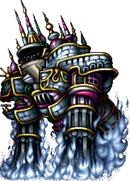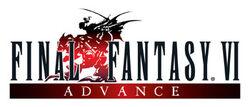Template:Sideicon
Template:Infobox CVG Final Fantasy VI is the sixth installment in the Final Fantasy series, first released in 1994 on the Super Nintendo Entertainment System. It was directed by Yoshinori Kitase and Hiroyuki Itou, who took over from the series creator and producer Hironobu Sakaguchi, director of the five previous installments. Long-time series contributor Nobuo Uematsu composed the musical score, while Yoshitaka Amano contributed to the image design.
Final Fantasy VI was the third installment in the Final Fantasy series to be released in North America (after the original Final Fantasy and Final Fantasy IV) and was first released in North America as Final Fantasy III to maintain the naming continuity. Due to various content guidelines imposed by Nintendo of America at the time, several other changes were made to the original North American version, including restrictions against nudity and profanity.
The game's story focuses on a conflict between the Gestahlian Empire conquering the world, and the Returners, a rebel faction opposed to them. The Empire has acquired a great army through experiments with espers, magical demi-gods of legend. The Returners seek magical power to fight the Empire on equal terms, and an amnesiac former imperial soldier, Terra Branford, proves key to both sides for understanding magic and espers.
Final Fantasy VI features fourteen playable characters, the largest cast of any main series game in the Final Fantasy series. The game is set in a fantasy steampunk-style world, at a technological level roughly corresponding to Earth during the second industrial revolution. It is the last title in the series to be released for the Super Nintendo console and the last title to be renamed; the next installment was called Final Fantasy VII on all regions.
Final Fantasy VI was ported to the PlayStation and released in Japan in 1999, both individually and as part of the Final Fantasy Collection. In North America, this port is available as part of the Final Fantasy Anthology. In 2002, the PlayStation port was released individually in Europe and Australia. A new port was released with additional content on the Game Boy Advance as Final Fantasy VI Advance on November 30th, 2006, in Japan, and February 5th, 2007, in North America.
In October 2013 it was revealed Final Fantasy VI would be ported to smartphones with updated graphics and adjustments to the battle system. It was released on January 15, 2014 for Android followed by an iOS release on February 6, 2014, and then another Android release on the Amazon Appstore for both Kindle and non-Kindle devices on December 8, 2014. The latter was made compatible with the Amazon Fire TV microconsole in September 2015. On December 16, 2015, this version was released on Steam.
Gameplay
The gameplay is similar to that of Final Fantasy V, utilizing the Active Time Battle system. Players can equip espers that teach magic and give stat boosts, similar to the jobs from Final Fantasy V. What abilities cannot be taught by espers can usually be learned by equipping relics, which give abilities like Jump and Two Hands. Party members can each equip a weapon, a shield, a helmet and a piece of clothing, each equipment piece often with its unique properties, such as stat boosts or elemental immunities.
Party swapping
Template:See Also
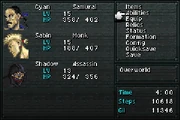
The Menu.
Unlike previous entries, such as Final Fantasy II and Final Fantasy IV, (though later made possible on the remakes), where party members come and go as the story dictates, Final Fantasy VI introduces the ability to change the party at almost any given time. Fairly early into the game—in a feature that would be repeated in later installments—players can form a party from whatever allies the resistance has gathered. Each ally has a specific talent; for example, Locke is a thief, Cyan is a samurai, and so on.
At times, such as the infiltration of the Southern Continent, the storyline demands that specific party members be taken along, but for the most part, the player can use whichever party they like. A total of fourteen playable characters were created for the game, each representing a different aspect of the traditional Final Fantasy job system and possessing a unique fighting style. Because of the vast number of characters, several dungeons require the player to form multiple parties, using two or three groups to cooperate to progress.
Espers and magic
Template:See Also
Though some characters have special abilities similar to magic, the only characters to learn regular spells naturally are Celes and Terra, although they have a limited spell pool. Most characters can learn magic by equipping magicite, or a few select pieces of equipment. Magicite is the crystallized remains of an esper, mystical creatures with intense magical power. Each character can equip a single piece of magicite at a time, and each magicite shard can be used by a single character at any given time. Once equipped, magicite teaches magic by way of Ability Points.
Each esper teaches a spell according to a percentage rate, and accumulating Ability Points from battles augments the equipped character's aptitude with that spell by the specified amount—once enough Ability Points have been won the spell is learned and can be cast. Some espers, such as Lakshmi, teach several basic spells quickly, while others, like Valigarmanda, teach a handful of powerful spells slowly. The system means that with patience any character, bar the secret characters Umaro and Gogo, can learn any spell.
In addition to teaching normal magic, the espers give access to summon magic. A character can summon their equipped esper once per battle. At times, the summons are merely more powerful versions of the spells they teach, like Ramuh; at other times they are entirely different, such as Quetzalli. Some espers give permanent stat boosts when the equipped character levels up with the magicite equipped to let characters modify their stats to suit whatever task the player wishes them to fulfill—even physical fighters like Edgar can be powerful mages with enough leveling to increase their Magic Power. The system gives summoned monsters a larger role in the party's strength than previous installments, something on which later installments, like Final Fantasy VIII, would expand on.
Characters
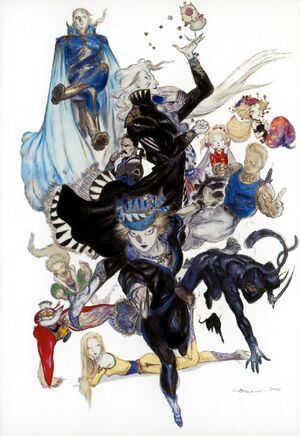
Artwork of the playable cast.
Final Fantasy VI features fourteen permanent player characters as well as a number of guest characters. Most of the main characters belong to the Returners, an underground resistance movement dedicated to overthrowing the Empire.
- Terra Branford, a girl who spent most of her young life being trained to be a weapon for the Empire.
- Locke Cole, a "treasure hunter" and rebel sympathizer.
- Edgar Roni Figaro is the king of Figaro and Locke's friend. He claims allegiance to the Empire while secretly supplying the Returners.
- Sabin Rene Figaro, Edgar's brother who fled the royal court to hone his martial arts skills.
- Cyan Garamonde, a loyal knight of the kingdom of Doma.
- Gau, a feral child surviving since infancy in the harsh wilderness known as the Veldt.
- Celes Chere, a former general of the Empire and a Magitek Knight, who joins the Returners following her imprisonment for questioning imperial policies.
- Setzer Gabbiani, the inveterate gambler and womanizer who joins the Returners offering the use of his airship to transport the heroes around the world.
- Shadow, a high-priced ninja mercenary who offers his services to both the Empire and the Returners.
- Relm Arrowny, a young girl living in the town of Thamasa with a passion for painting.
- Strago Magus, an elderly Blue Mage, Relm's adoptive grandfather and one of the few remaining Magi.
- Mog, a talking moogle from the Narshe Mines.
- Umaro, a savage but loyal yeti living in the Narshe Mines who answers only to Mog.
- Gogo, a mysterious, fully shrouded master of the art of mimicry who agrees to lend support only when the party finds its way to the lair in the stomach of a giant monster.
A handful of Final Fantasy VI characters have reappeared in later games, such as Secret of Evermore and Kingdom Hearts II. A short technical demo, Final Fantasy VI: The Interactive CG Game, produced for the Silicon Graphics Onyx workstation, featured 3D rendered versions of Terra, Locke and Shadow.
Setting
The ancient War of the Magi... When its flames at last receded, only the charred husk of a world remained. Even the power of magic was lost... In thousand years that followed, iron, gunpowder, and steam engines took the place of magic, and life slowly returned to the barren land... Yet there now stands one who would reawaken the magic of ages past, and use its dread power as a means by which to conquer all the world... Could anyone truly be foolish enough to repeat that mistake?
Intro
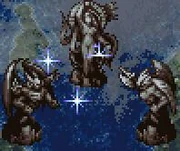
The Warring Triad.
A thousand years ago three gods, known as the Warring Triad, descended upon the world and warred for dominance. The conflict became known as the War of the Magi, during which the gods transformed humans and animals into creatures called espers, giving them magical powers. The gods realized the war was destroying the world and petrified themselves, their final wish being that the espers prevent their power from being abused. The espers took the gods' statues and fashioned a new dimension where they could live peacefully away from humans, and to hide away the gods.
In the present, the world has experienced a technological revolution while magic has faded into legend. To the south, the Gestahlian Empire led by Emperor Gestahl discovered the entrance to the Esper World and kidnapped several of the creatures. The Empire discovered a way to drain the espers of magical energy and imbue humans and machines with this power; this technology is known as Magitek. Overpowering the armies of other nations, the Gestahlian Empire conquered the southern continent and began to push into the north with the aim of world conquest.
Story
The mysterious woman
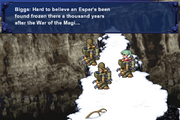
The Empire gets ready to attack.
Two Imperial soldiers, Biggs and Wedge, accompany a woman to raid the neutral city of Narshe using Magitek Armor due to reports of a frozen esper having been dug up in a mine shaft. In the rear of the newest mine they find the esper, Valigarmanda, that sends out pulses of magical energy, killing Biggs and Wedge and destroying the woman's Magitek Armor. She awakens in the home of a man named Arvis, who explains she was being controlled by the Empire with a slave crown. Amnesiac, the woman has no other knowledge of her identity than her name: Terra.
The Narshe guards arrive to arrest her, and Arvis sneaks Terra through a back door into the mines. Terra is cornered and falls down a shaft into another area of the mines. She falls unconscious, remembering a man named Kefka Palazzo who placed the slave crown on her and ordered her to burn fifty Imperial soldiers as a test.
A man named Locke arrives at Arvis's house. Arvis and Locke are members of the Returners, a rebel faction opposing the Empire, although Narshe remains neutral. Arvis asks Locke to get Terra safely out of the city, and with the help of Mog and the other moogles who live in the mines Locke fights off the Narshe guards and escapes with Terra.
The two travel south to Figaro Castle, a desert nation allied with the Empire, where Terra meets the flirtatious king Edgar. Edgar attempts to hide Terra from the Imperial ambassador, Kefka, who arrives looking for her. Locke tells Terra Edgar's alliance with the Empire is superficial—in truth, he collaborates with the Returners using Locke as a go-between.
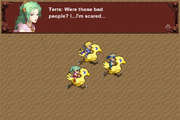
The party in the desert.
Kefka sets the castle aflame and Terra, Edgar and Locke flee on chocobos while the castle burrows into the sand. Kefka sends two Imperial soldiers in Magitek Armor to attack the trio, and during the battle Terra casts magic, stunning Edgar and Locke. Intrigued by Terra, Edgar and Locke ask her to meet with the leader of the Returners, Banon, to remain safe from the Empire and to gain understanding of her abilities. Terra agrees, and they travel to South Figaro and then north through Mt. Kolts where they encounter Vargas, son of the martial arts master Duncan Harcourt, having recently murdered his father out of jealousy and hate. Edgar's twin brother and Duncan's pupil, Sabin, intervenes and defeats Vargas, and joins his brother to help them stop the Empire.
At the Returner Hideout, Banon, the Returners and Terra discuss their plan to strike back at the Empire. Deducing the Empire's power derives from the rediscovery of magic, Banon asks Terra to return with him to Narshe and speak to the frozen esper. The group receives word the Empire has attacked South Figaro and has discovered their hideout. Locke volunteers to sneak into South Figaro to slow down the Empire, while Banon, Terra, Edgar and Sabin travel to Narshe along the Lethe River. The voyage is interrupted by a loud octopus named Ultros, and during the battle Sabin washes down a different fork in the river.
Return to Narshe
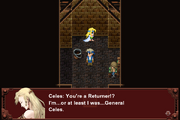
Locke rescues Celes in South Figaro.
While Locke sneaks out of Figaro he rescues an Imperial general turned traitor named Celes, and the two head north to Narshe. Sabin washes ashore north of the kingdom of Doma, and with the help of a ninja mercenary Shadow, infiltrates an Imperial camp as the Empire attacks Doma Castle under General Leo Cristophe's command. The Doma retainer Cyan dispatches the Imperial commander to stall the attack, and Kefka poisons the river, killing Cyan's family and nearly all the castle inhabitants.
Cyan joins Shadow and Sabin as they escape aboard the ghostly Phantom Train, which ferries the dead to the other side. Cyan witnesses the Doma dead and his wife and child among those boarding the train. Shadow leaves as Sabin and Cyan leap down Baren Falls to Mobliz, and on the nearby Veldt they befriend a wild child named Gau who shows them a diving helmet they use to swim to Nikeah, where they board a ferry to South Figaro.
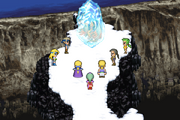
The party watching the frozen Esper on Narshe Cliffs.
Terra, Banon and Edgar arrive at Narshe and rendezvous with Arvis. The four urge the Elder of Narshe to join them as the esper will draw Imperial attention. The others arrive, and Celes knows the Empire is already marching on Narshe. The Returners station in the mountains to the esper's resting place as Kefka leads the attack to claim the creature. Dispatching the Imperial forces and chasing off Kefka, the Returners save the town. They approach the esper on the cliffs over the town and it reacts to Terra's presence. A surge of energy transforms Terra into a glowing pink monster, and she flies away with a scream.
Magicite
Several of the Returners remain to protect Narshe while a search party heads to the west to find Terra. Using Figaro Castle to burrow under the mountains to Kohlingen, they continue south to Jidoor and then to Zozo, a town of thieves. Atop the highest building the group finds a transformed Terra under the care of the esper Ramuh who tells the party about the War of the Magi and the Imperial invasion of their realm, and that he called Terra to him to put her to rest when her powers awoke. Ramuh had escaped the Empire with three comrades who fell during the escape and turned to magicite.
Ramuh says the Empire's methods of forcibly extracting magic from espers results in a weaker form of magic, but when an esper dies and crystallizes into magicite their abilities can be transferred in full. Terra needs to accept her powers, but Ramuh urges the party to rescue the other espers in the Imperial capital, and turns himself into magicite, entrusting the Returners with his power and the power of his friends to fight the Empire.

Celes sings in the opera.
Celes leads the expedition with Locke accompanying her. As no boats go to the southern continent, the group returns to Jidoor where they meet the Impresario, who worries Setzer Gabbiani, the "wandering gambler", will abduct Maria, the star of the opera "Maria and Draco". Setzer owns the only private airship in the world, the Blackjack, and since Celes bears an uncanny resemblance to Maria, Locke hatches a plan for Celes to take Maria's place in the opera as a ploy to gain access to Setzer's airship. Ultros overhears the plan and during the performance attempts to drop a weight on Celes. Locke and the others stop him, but the show is ruined, and in the commotion Setzer abducts Celes. Celes helps Locke and the others sneak on board the Blackjack, and Celes tricks Setzer into helping them using a two-headed coin.
Setzer flies the group to Albrook and they set off north of the Imperial capital of Vector. With the help of a Returner sympathizer they sneak into the Magitek Research Facility where Magitek weapons are manufactured. Witnessing Kefka torturing two espers, Shiva and Ifrit, they overhear him declare he will revive the Warring Triad. Shiva and Ifrit entrust their magicite to the group, and they continue through the facility and release several espers being drained of their power.
Their efforts are in vain as the espers are too weak and turn to magicite. The Imperial magicite researcher, Cid, arrives and tells Celes the rumors that she is acting as a spy for the Empire. Kefka appears and claims the rumors are true. Locke begins to doubt her, and Celes teleports herself and Kefka away as the facility begins to overload. Cid helps the party escape on a mine cart, and they meet with Setzer and return to Zozo, destroying two cranes Kefka uses to try to destroy the Blackjack.
Allying with the Empire
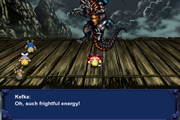
Espers coming to the human realm.
In Zozo, one of the magicite remains the party acquired from the Magitek Research Facility is revealed to be that of Terra's father, Maduin, who restores her memories. Terra explains she is half-human and half-esper, born from a human named Madeline who had entered the esper realm and befriended Maduin. When the Empire attacked two years later, Terra was taken along with Maduin and raised as a Magitek experiment due to her natural magic powers. Now accepting who she is, Terra and the party return to Narshe and tell the others of their plan to attack the Empire using the machinery of Figaro and the resources of Narshe, but they lack manpower. They decide to open the gate to the esper world and ask their help: as a hybrid, Terra is living proof the two races can co-exist peacefully.
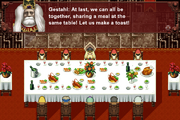
Emperor Gestahl meets the Returners.
At the gate to the esper world Kefka appears as Terra begins to call out to the espers. Her cries open the gate and the espers rush out, decimating Vector and crashing the Blackjack. In the Imperial Palace Emperor Gestahl tells the party the espers' power has made him realize the error of his ways. He declares a truce and asks the Returners and Terra to help him locate the espers that fled the gate and make them understand the war is over.
Terra and Locke accompany General Leo to Crescent Island to track the espers. To assist their efforts, Leo has hired Shadow. Celes accompanies them as well, acting as an Imperial general. When approached, she refuses to speak to Locke or Terra due to their earlier suspicion of her true motives.
At Crescent Island, Terra, Locke and Shadow split from the Empire and find the backwater town of Thamasa where Strago and his granddaughter Relm feign having no knowledge of espers or magic. Relm gets trapped in a burning building, and the townspeople reveal they can use magic when trying to put the fire out. Terra, Locke, and Strago enter the building to save her and are rescued by Shadow, who has come to get his dog, Interceptor, that had followed them inside.
Strago explains Thamasa was founded by magic-imbued humans after the War of the Magi who sought to live normal lives, and as their descendants, the townsfolk have some magical power. Strago agrees to help Terra and Locke locate the espers, and though Relm wishes to help too, Strago refuses. Shadow leaves to find the espers on his own with Interceptor.
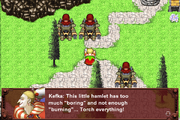
Kefka orders Thamasa burned.
At the Esper Caves a third run-in with Ultros prompts Relm to intervene and save the party with her ability to sketch living portraits of monsters, and Strago agrees to let her join them. The group finds the espers led by Yura, now apologetic about the destruction of Vector as they lost control of their powers when passing through the gate between realms. In Thamasa, General Leo and Yura reach a truce, but Kefka arrives and kills the espers, takes their magicite and knocks out the party, claiming he is acting under the Emperor's orders. When Leo tries to stop him Kefka kills him.
The gate to the esper world flies open and several espers race to attack Kefka, but he destroys them and takes their magicite before departing. Alerted to the Empire's treachery, Setzer and the other Returners, sans Banon, arrive at Thamasa in the Blackjack. Kefka and Gestahl enter the esper realm and find the remains of the Warring Triad and use their power to raise the Floating Continent.
The rise of Kefka

Celes stabs Kefka.
The Returners board the Floating Continent, fighting the Imperial Air Force, as well as Ultros and his friend Mr. Typhon. They find Shadow, who had kept working for the Empire until they tried to kill him. After a battle with the legendary Ultima Weapon, Shadow departs as the Returners confront Kefka and Gestahl before the Warring Triad. Celes arrives as Gestahl paralyses the party, and he and Kefka urge Celes to return to their side and kill her friends so the three of them can rule the world. Celes refuses and stabs Kefka.
Kefka attempts to awaken the Triad and Gestahl, knowing this would lead to a disaster, tries to stop him but is struck down. Kefka kicks Gestahl off the Floating Continent to his doom and moves the statues out of alignment. Celes warns him the Triad's powers will go haywire, but Kefka laughs it off. With Shadow's assistance the party flees to the Blackjack, but the Warring Triad's magical field has been destabilized and radically shifted the face of the planet. The Blackjack is destroyed and the party is scattered around the world.
A year passes, during which Kefka raises a tower of ruins over the former Vector and drains the Warring Triad of their power becoming the God of Magic. The new world born from the destruction of the old is a dying one where many plants and animals are mutated from the magical fallout and cities have been destroyed and decimated by Kefka's Light of Judgment, a beam of energy he uses to strike down anyone who opposes his rule.

Celes leaves the island.
Celes awakens on a small island with Cid, who tells her of the state of the world. Cid either lives or dies as Celes cares for him and either in person or via a letter, Cid shows Celes a raft he has built and tells her to find her friends. Celes returns to the mainland, and in Tzen finds Sabin. Confident the others have survived as well, the two continue to Nikeah and find a man who resembles Edgar, named "Gerad", leading a band of thieves.
They follow him on a ship to South Figaro and into a cave leading to the buried Figaro Castle. Edgar reveals he used the alias "Gerad" to trick the thieves into helping him enter Figaro since it was lost under the sand. In Kohlingen the three find Setzer who shows them the tomb of his friend Darill, who owned an airship, the Falcon. With the recovered Falcon the group travels the world, discovering many long-lost secrets of the War of the Magi unearthed by the world destruction.
The gathering
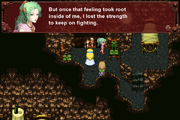
Terra losing her strength to fight.
In Mobliz, the group finds Terra taking care of the village children after their parents perished in the apocalypse. Though she does not wish to fight, she is forced to battle a monster Humbaba to protect the children, discovering her love for them.
The group finds Cyan living in Mt. Zozo carrying on a long-distance romance with a young woman called Lola, who believes him to be her dead boyfriend. Strago, believing Relm is dead, has joined the Cult of Kefka, while Relm is a painter working in Jidoor for Owzer. Shadow, knowing nothing but fighting in his life, battles in the Dragon's Neck Coliseum.
Locke, seeking a way to revive his dead lover Rachel, enters the Phoenix Cave to find the magicite of the esper Phoenix: it revives Rachel briefly, but long enough for Locke to come to terms with his guilt for failing to save her.
Mog and Gau have returned to their homes in the Narshe Mines and on the Veldt. In the Narshe Mines, the yeti Umaro can be recruited, and the mime Gogo will join the party inside the Zone Eater on Triangle Island.
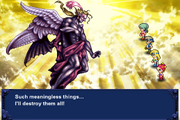
The final battle with Kefka.
With their ranks reassembled the Returners attack Kefka's Tower knowing that if they destroy the Warring Triad magic will vanish from the world, leading them to wonder what will happen to Terra. At the summit Kefka tells the party mortal lives are without meaning or significance, as ultimately everything people build is destroyed and nothing they do impacts on the world.
The party tells Kefka the bonding over day-to-day struggles gives people the will to live on in spite of the hardships. Kefka turns the Light of Judgment on the world before attacking the party. Upon confronting Kefka as the God of Magic he exclaims he'll destroy all dreams and hope before breaking down into hysterical laughter.
Kefka is killed, and with him the essence of magic vanishes. The espers' magicite remains dissolve, but Maduin tells Terra she can endure as a human if she has a strong emotional attachment to something in the world. With the last of her power, Terra leads the group out of the tower aboard the Falcon. She falls onto the main deck, and after regaining consciousness finds herself fully human due to her love for the children of Mobliz. The party flies across the world and witnesses the cities rebuilding. Terra steps to the bow of the Falcon and releases her ponytail to the wind, finally free to live and enjoy her life as she wishes.
Music
Template:See Also The soundtrack is the work of long-time series contributor Nobuo Uematsu. The score consists of themes for each major character and location, plus a standard battle theme and for fights with boss enemies, as well as for special cutscenes. The "Aria di Mezzo Carattere" plays during the opera and features an unintelligible "voice" that harmonizes with the melody—the limitations of the cartridge size prevented the use of an actual vocal track.
The orchestral album Final Fantasy VI: Grand Finale features an arranged version of the aria, featuring Italian lyrics, performed by Svetla Krasteva with orchestral backing. The aria is also found in the second full motion video in the PlayStation re-release with the same lyrics, but a different musical arrangement. In addition, the album Orchestral Game Concert 4 includes an extended version of the opera. Arguably the most famous sequence in the game, Electronic Gaming Monthly declared the opera scene one of the "20 Greatest Moments in Console Gaming" in 2002.
Final Fantasy VI: Grand Finale features eleven tracks from the game, arranged by Shiro Sagisu and Tsuneyoshi Saito and performed by the Ensemble Archi Della Scala and Orchestra Synfonica di Milano. Piano Collections: Final Fantasy VI, a second arranged album, features thirteen tracks from the game, arranged and performed for piano by Reiko Nomura. Additionally, the original score was released on three compact discs in Japan as Final Fantasy VI: Original Sound Version. A version of this album was later released in North America under the title Final Fantasy III: Kefka's Domain, available exclusively through mail-order from Squaresoft.
Development
I still remember when, during the launch party for Final Fantasy VI, the notoriously unforgiving Mr. Sakaguchi gave a speech. 'Thanks to every one of you — we have created the best game in the world! No! The universe! Thank you!' I cried. There were tears on my face. Those tears made me realize just how much I had invested myself in the project. I hope that the Final Fantasy games forever continue to be a source of joy not only for the fans, but for the developers as well!
Nobuo Uematsu, liner notes to Final Fantasy XIV / Battle Tracks
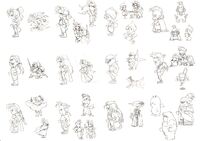
Concept art by Tetsuya Nomura of the main cast as they would appear in the game.
Work began on Final Fantasy VI almost immediately after the international release of Final Fantasy V in 1992. The production lasted around one year with a 50-60 member team.[1] The game launched on schedule and within budget, but not without the strain of a significant crunch towards the end of production to iron out remaining issues in the code; director Yoshinori Kitase has described the final debug phase as "an exhausting affair".[2] Despite the team's efforts, the game has a myriad of programming oversights and glitches. Managing memory was a challenge, as at the time it couldn't be entrusted to computers and had to be done manually, meaning human errors were much more prevalent, and Square had no tools or software to aid programmers in detecting errors.[3]
Though not the first game to utilize the Mode 7 graphics of the Super Nintendo, Final Fantasy VI made more extensive use of them than either of its two predecessors. Unlike both Final Fantasy IV and Final Fantasy V, for example, the world map is rendered in Mode 7, which lends a somewhat three-dimensional perspective to an otherwise two-dimensional game.

FMV sequence showing Celes as an opera singer.
Yoshitaka Amano, a long-time contributor to the Final Fantasy series, returned as the image designer providing concept sketches to the programmers, who converted them into the in-game sprites. Some liberties were taken during the conversion, such as the changing of Terra's hair from blonde to green. The PlayStation release includes full-motion video produced specifically for the re-release: the character designs in these video sequences are based on Amano's designs, rather than the in-game sprites.
Final Fantasy VI was Yoshinori Kitase's first directorial job in the Final Fantasy series, as Hironobu Sakaguchi placed him in charge of event production. Kitase was tasked with unifying the scenarios and dramatic sections in the game into a coherent narrative.[2] Hiroyuki Itou supervised the development of battle aspects, and it was up to Sakaguchi to bring the project together as a whole piece.[2] Aside from the story, Final Fantasy VI had many details undecided when development began, and a great many things were filled out along the way.[4]
Sakagutchi has said that sometimes RPGs force too many images and too much sound onto the players robbing them of the feel of control, and to avoid those responses Square did extensive research during Final Fantasy V and VI in how to make players feel interactively involved in the game while upgrading the visual and sound effects. [5]
The logo features a Yoshitaka Amano drawing of Terra Branford atop a Magitek Armor, depicting an event when she was in the thrall of the Gestahlian Empire. The armor and its rider are in black and red, while the text is black, from here on becoming standard for the series. Amano considers the logo memorable as at the time was Terra was one of the first female main characters in the series and the logo is just the silhouette without faces and lines; Amano describes early logos in the series as more simplistic that gradually became more illustration-like.[6]
Scenario
Looking at videogame design and development up to that point, I supposed that action games, for example, relied on sense and instinct while RPGs appealed more to reason and logic. What made the Final Fantasy series so innovative was the emotion realized from drama within the game in addition to those other elements. I believe this innovation was more apparent than ever before in the sixth game. This game really brought that creative goal into full bloom.
Yoshinori Kitase[3]
The base idea for Final Fantasy VI was that every character would be the story's protagonist.[4] Everyone on the development team contributed ideas for characters and the game was to feature individual character episodes. Director Yoshinori Kitase has later commented that the influence of Final Fantasy VI may have been responsible for the greater emphasis on character creation in subsequent Final Fantasy titles.[2]
The production was a hybrid process: Sakaguchi came up with the story premise, based on a conflict with imperial forces, but as the framework was designed to provide leading roles to all characters, everyone on the team could provide ideas for character episodes, it being Kitase's job to join the episodes together.[2] Locke and Terra are colored by Sakaguchi's influence, whereas the episodes for Shadow and Setzer were devised by Tetsuya Nomura, and Kaori Tanaka provided suggestions for Edgar and Sabin, among others. Kitase himself devoted his efforts to create Celes and Gau.[2] The idea was to grow the Final Fantasy characters of the time from mere ciphers for fighting into characters with substance to evoke complex feelings in the player.[2]
Maintaining an equilibrium between the cast was a challenge. Looking back at the game Kitase has commented on having somewhat lost this balance. For example, Celes and Kefka became more influential than originally intended.[3]
Early screenshots of the original Japanese version reveal some divergent plans made during development. At the start of the game, instead of Valigarmanda being the frozen esper, Maduin appeared encased within the ice. Though Final Fantasy VI is the first appearance of Biggs and Wedge (ビックス and ウェッジ), they were originally going to be called Les and Bafra (レス and バフラ).
Localization

SNES logo.
The English language localization for the Super Nintendo includes a number of changes to the original Japanese game. The most obvious is the alteration of the game title, which was changed to reflect it being the third Final Fantasy title to be released in North America. Unlike Final Fantasy IV (originally released in North America under the title Final Fantasy II), there are no major changes in gameplay, though certain editorial alterations exist in the English script.
English translation
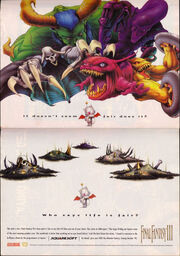
North American Final Fantasy III magazine ad.
The game's English translator, Ted Woolsey, was granted just thirty days to complete his work.[2] The localization process started when the game was basically finished for the Japanese release. Woolsey was given a short amount of time to do the job, and was handed the game cartridge and the files to work with.[7] The aim was to hit a late summer deliverable and there was still a two to three-month manufacturing window for the SNES cartridges, which had to be taken into account.[7]
Unlike with Final Fantasy II (originally called Final Fantasy IV in Japan), Final Fantasy III had a remake staff with a part of the development team and people brought in specifically to help with the localization for the English and European versions. Woolsey was given free reign to do anything with the text until he'd get it down to a size it would fit. He translated the game, which consisted of around 1,300 pages of text broken into pieces, as the scenario writers had just taken a chunk of scenario and dumped it in not caring where it was put in the data.[7]
The first version Woolsey finished and sent to Tokyo was three or four times too large, despite having aimed for brevity. A lot of the scatological humor would have to be expunged for Nintendo's purposes, and some pop culture references Woolsey had thought clever had to be ditched for branding, licensing and registration issues. Woolsey did another pass at the text but it was still much too large, leading Woolsey to abandon the original translation and look at each section separately to re-imagine it. What inconvenienced the work was that the game events were pre-scripted and so could not be tweaked for a timing better fit for a new translation.[7]
Initially Woolsey got plenty of positive fan mail and the game was reviewed well, but after seeing things on the Internet he became aware of certain issues, such as side quests he had never actually played himself before having translated them, not knowing the gender of the person performing the actions. Woolsey was surprised by some of the more negative reactions to his translation, but nobody at the time of the original development knew of the degree to which players would come to revere the game.[7]
The North American and European PlayStation port retains the bulk of Woolsey's original translation with minor changes, including the return to the original Japanese title of Final Fantasy VI, and a number of character and item names alterations.
Censorship
Template:See Also In a January 1995 interview with Super POWER magazine, translator Ted Woolsey explained that "there's a certain level of playfulness and... sexuality in Japanese games that just doesn't exist here [in the USA], basically because of the rules of Nintendo of America and guidelines". Some of the graphics are subtly changed to cover up instances of nudity and more risqué sprites. Another example of censorship includes removing the smoke from the sprites of enemies such as Misty (originally "Dahling"). Even some signs were changed from 'Bar' to 'Café'.

| ||
| The North American graphics for Siren were edited to cover up a minor instance of nudity.
From left to right: Japanese & PlayStation (all), American SNES, and American/Euro Advance. | ||
The English localization features several name changes. Some such alterations were necessitated by length restrictions (e.g. "Stragus" was shortened to "Strago"). Other changes were made for the game to meet the aforementioned content guidelines from Nintendo, which, for instance, placed restrictions on the use of religious imagery, leading to the rechristening of the magic spell "Holy" to "Pearl". A number of changes were made because of cultural differences between Asian and North American audiences. For example, Terra's Japanese name, Tina, sounds exotic to Japanese speakers, but is a common Anglophone name.
While the translation remained in the PlayStation port, the censorship present in the SNES version was lifted, and all versions of the PlayStation release used the original sprites. This remains true for the Finest Fantasy for Advance release, although instead of using the uncensored Japanese version of Siren, a third Siren sprite was used which was more covered than the original Japanese sprite, but less so than the original North American release. The mobile/Steam version's Siren is based on the GBA version.
The scene where Celes is being tortured by the Empire was removed for the Game Boy Advance release of Final Fantasy VI. This is because the original Final Fantasy VI was created before the Japanese ratings board, CERO, existed. Violence is rated strictly in Japan, and Square wanted a CERO A rating for the Game Boy Advance version, which would have been impossible if a game depicts violence against a restrained human.[8]
Themes
Final Fantasy VI takes a step toward a more corporeal world from the mainly medieval fantasy settings of past Final Fantasy games, depicting a world amid industrial revolution, progress being championed by the Gestahlian Empire, while the more traditional societies still live by the ways of old, such as Doma. The game's overall color scheme is more rustic and earth tones than with Final Fantasy V, shown in both character sprites and backgrounds.
The story of Final Fantasy VI draws from more eclectic sources of influence than just mythology and popular culture as with previous titles, including many Italian influences, including opera and literary works such as Dante's Divine Comedy. Final Fantasy VI introduced character themes to the series where the cast have instantly recognizable "theme tunes" playing during key events relating to said character, in the vein of Italian opera. The role of the playable cast was broadened in that personal storylines were made a staple, rather than the playable cast's stories mainly relating to the overall quest of saving the world, as was with previous Final Fantasy titles. To this end, Final Fantasy VI was created with an ensemble cast with the player able to set the main character and choose the active party.
The story has themes of dualism and separation. The world is torn between the old and the new ways of life, industrial cities and medieval castles being contemporaneous. Unbeknown to most people the world itself is split with another realm inhabited by magical beings lying hidden in its depths. The world is literally split when the Warring Triad are moved our of alignment, and the game can be divided by its two halves: the World of Balance and the World of Ruin. Similar themes are present in the cast, with Terra Branford being half-human, half esper; Celes being an Imperial General and sympathetic with the Returners; Kefka Palazzo being simultaneously a clowning jester as well as power-hungry and evil, achieving an angelic god form in juxtaposition to his declaration of love and hope being meaningless; the separation and the opposing ways of lifeEdgar and Sabin, the twin brothers, have chosen for themselves; and Shadow's two sides with his discarded past and the new persona he has made for himself to conceal it, among others.
The main theme could be said to be the search of meaning for life and how each person's quest is different. Kefka, unable to find meaning outside of destruction, declares love and hope pointless, but at the story's climax the party confronts him as each have discovered something during their quest that fuels their will to persist even in a ruined world. In the end, their conviction proves stronger than Kefka's.
Another major theme is coping with the death of loved ones. Most the cast have lost someone close to them and their struggle to cope with the loss plays a major role in their personal stories: Locke lost his beloved Rachel; Cyan has his family murdered by Kefka when Doma is poisoned; Celes's possible loss of Cid leads to her attempted suicide; the Figaro brothers lost their father, leading Sabin to abandon the life of royalty; Kefka's killing of Leo impacts the whole party and especially Terra; Shadow abandoned his companion; and Setzer lost his friend in an airship crash. Throughout the World of Ruin many of the story arcs involve a party member trying to cope with their loss and move on.
Ports and remakes
PlayStation
Final Fantasy VI was the third and last of the Super Nintendo Final Fantasy titles to be ported to the Sony PlayStation, and was released a year after a similar port of Final Fantasy V, and two years after a port of Final Fantasy IV. It was followed by a remake of the original Final Fantasy and Final Fantasy II in the compilation Final Fantasy Origins. In Japan, the PlayStation port was released individually and alongside both Final Fantasy IV and Final Fantasy V as a part of a limited edition boxed set titled Final Fantasy Collection. In North America, the port was released alongside Final Fantasy V as part of the Final Fantasy Anthology. In Europe, the game was released individually (along with a demo of Final Fantasy X), making it the first time the game had been officially released in territories using the PAL system.
Technically, the PlayStation port is similar to the original Super Nintendo version. Aside from the addition of a few new full-motion video cutscenes before the original opening and after the original ending, the graphics and sound are unchanged. Unlike the re-release of Final Fantasy IV in the Final Fantasy Chronicles compilation, the script for the North American PlayStation release was essentially left unchanged; gil remained "GP", and Ultima Weapon "Atma Weapon".
The only notable changes to gameplay were the revision of Vicks to Biggs, the correction of a handful of bugs, and the addition of a new "memo save" feature, which allows players to quickly save their progress to the PlayStation RAM. Due to the volatile nature of the system's memory memo saves are lost if power to the console is interrupted. The port includes a number of bonuses, including a bestiary and artwork gallery that can be accessed from the main menu, and which are revealed as the player progresses through the game.
Game Boy Advance
A port of Final Fantasy VI for handhelds had been considered by Square in early 2001. The project failed due to the absence of an appropriate platform—the WonderSwan Color was not powerful enough to run the game, and Nintendo did not allow Square to develop on the Game Boy Advance despite Sakaguchi's wishes.
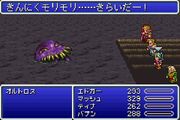
Original gameplay of the Advance port.
Years later, after relations between Square (now Square Enix) and Nintendo improved, it was announced Final Fantasy VI would be re-released on the Game Boy Advance under the title Final Fantasy VI Advance. This is consistent with the re-releases of Final Fantasy IV (released in North America on December 12, 2005) and Final Fantasy V (released in North America on November 6, 2006). Final Fantasy VI Advance was released on February 5, 2007. Like the other Game Boy Advance re-releases, several extra features were added, including the bonus dungeons Dragons' Den and Soul Shrine, and a new superboss, Kaiser Dragon. The Game Boy Advance port fixed many bugs from in the previous versions, including the Vanish-Doom bug. The Game Boy Advance conversion, however, suffers lower sound quality than the original Super Nintendo version.
PlayStation Network
A port of the PlayStation version was released for PSN in Japan on April 20th, 2011 and in PAL territories on June 3rd, 2011. The North American PSN port of the PlayStation version was released on December 6th, 2011.
Virtual Console
Square Enix released Final Fantasy VI as Virtual Console download in Japan in June 2013 for ¥900.
Mobile
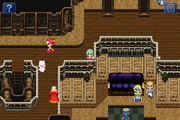
Final Fantasy VI for smartphones.
At the end of a press conference for the Android and iOS versions of Final Fantasy V and Final Fantasy IV: The After Years it was revealed Final Fantasy VI would be receiving a remake for Android and iOS devices.[9] Its graphical presentation is enhanced compared to previous versions in highly-detailed 2D, like the systems' versions of Final Fantasy V and Final Fantasy Dimensions, rather than the 3D graphics of Final Fantasy III, Final Fantasy IV, and The After Years.
This version has some alterations to the battle system to make grinding less of an issue. It doesn't have a run button, and characters can move diagonally, although in the config one can turn off the eight-way-controls and set it to the traditional four-way. The menu system in battles has been revamped. The character options slowly rise up as the ATB gauge fills allowing the player to use the right character at the right time without having to hit a button to rotate through the roster. Sabin's Blitz commands and Cyan's Bushido commands are input differently than in older versions. Like the other mobile remakes, there is an indicator to signal one can interact with objects and people. In the menu the player can play the entire soundtrack. The Album is a new menu feature that chronicles the game's moments allowing one to catch up on the story. Achievements have been added. The game uses the post-battle quicksaves like the other mobile ports do, meaning that if one accidentally levels up with the wrong esper equipped they can get a do-over.
The game uses the GBA version translation, and all previously Advance exclusive content is also included. The music is of the original SNES version quality. The in-game sprites and menu portraits have been remade by Kazuko Shibuya who also made the original sprites for Final Fantasy VI. The menu portraits are based on the original portraits, which in turn were based on Yoshitaka Amano's illustrations. The in-game sprites appear to be made after the Final Fantasy V Android/iOS sprites and Kazuko Shibuya's character artworks.
The iOS version supports saved data that can be synced to other iOS devices via iCloud. Final Fantasy VI requires iOS devices running iOS 7 or later—although iPhone 4 users are urged to save the game frequently due to suffering performance issues during gameplay.
A menu screen window consisting of artwork of Terra was provided by the social game Pictlogica Final Fantasy and may be obtained by entering a code received within the game.
A new menu screen window could be obtained by entering a code received from a cross-collaboration with the social game Final Fantasy Tactics S. In turn, a code could be received for Final Fantasy Tactics S wherein players could acquire the Rare cameo character, Runic General Celes. This offer was exclusive to the Japanese mobile versions of Final Fantasy VI.
On 9 October 2014, the Android/iOS app received an update that included new features such as game pad support, more translations, as well as cloud saving for the Android version.[10]
Later, the more stable app would be released on additional platforms. The Amazon Appstore version received Fire TV support in September, 2015. In December 8 2015, the mobile version was ported and released on Steam.
Template:Gallery
Microsoft Windows (via Steam)
The mobile version was released on Steam on December 16, 2015.[11]
System requirements
| Minimum | Recommended | |
|---|---|---|
| OS | Windows Vista, 7, 8, or 8.1 | |
| Processor | Intel® Pentium 4, 2.4 GHz | |
| Memory | 2 GB RAM | |
| DirectX | Version 10 |
Steam Trading Cards
The game comes with five trading cards to be collected.
Template:Gallery
Reception
Upon release, Final Fantasy VI was met with widespread critical acclaim but wasn't a huge a commercial success in North America. Hironobu Sakaguchi has later lamented that in terms of the pixel art and the character size, the game "didn't jive" and that's why Final Fantasy VII got bigger with 3D models and CGI graphics.[12] In Japan the absence of crystals—a recurring theme through previous Final Fantasy titles—and the milieu being a technological civilization, bewildered some of the old fans. However, the impact of the opening scene, with Magitek Armor traversing through snowy fields, was well regarded, and fans were willing to accept the game's culture and it was mostly well received at the time.[3]
The game currently holds a 92% approval rating on IGN, and the gaming magazine Nintendo Power listed it as the eighth greatest Nintendo game. ScrewAttack called it the third best SNES game, only behind Legend of Zelda: A Link to the Past and Super Metroid. As of March 31, 2003, the game had shipped 3.48 million copies worldwide, with 2.62 million of those copies being shipped in Japan and 860,000 abroad.
The 200th issue of Game Informer Magazine features multiple covers based on their top ten games ever. Final Fantasy VI was the only Final Fantasy game featured in the top 10, placing eighth, but Final Fantasy IV (80th), Final Fantasy VII (15th), Final Fantasy X (43rd), Final Fantasy XII (112th), Final Fantasy Tactics (45th), and Vagrant Story (184th) could be found throughout the list.
In another 200th issue of a magazine, this time Electronic Gaming Monthly, the game ranked as 36th on their "Greatest 200 Videogame of their time" list.
In 2012, IGN ranked Final Fantasy VI as the #1 RPG of all time.
The reception to the various ports has been more mixed. The PlayStation port was criticized for slow load times, and the mobile port has gotten a mixed reception, with some criticizing the sprite art. The Android and iOS version launched with an unfinished feel, with an obvious typo in one of the very first story sequences, and a fatal glitch that would always crash the game during a cutscene, making the initial version unfinishable. Square Enix quickly responded by releasing a patch.
The port has good reviews on both Google Play and the App Store, normally averaging 4.5 stars on both stores, though many fans found the new character sprites off-putting. On the Amazon Appstore, the port doesn't show good ratings (at 2.5 stars average) due to the lack of Android Lollipop support, lack of cloud saving, and the version being 1.0.0. Version 1.0.0 on Amazon comes with controller support, which was added in a later Google Play update. As of the 17th of April 2015, Square Enix pushed the 1.0.2 update to the Amazon Appstore to support Android Lollipop in response to user reviews. Later, as of September 2015, Fire TV support was added, while not addressing the lack of cloud saving.
When Final Fantasy VI first launched Internet wasn't as widespread and, as a more junior staff member, director Yoshinori Kitase wasn't given the opportunity to travel overseas. Thus he wasn't aware of the reception the game received outside of Japan. However, in later years as he tagged along on PR tours to Europe and America he had the opportunity to talk with foreign media and fans, being taken aback by the number of westerners asking him to sign their Final Fantasy VI cases. He has commented that in Japan that would apply more to Final Fantasy VII, but he gets the impression there are many players in the West who prefer VI.[3]
Production credits
| Producer | Hironobu Sakaguchi |
|---|---|
| Directors | Yoshinori Kitase, Hiroyuki Itou |
| Main Programmers | Ken Narita, Kiyoshi Yoshii |
| Graphic Directors | Tetsuya Takahashi, Kazuko Shibuya, Hideo Minaba, Tetsuya Nomura |
| Music | Nobuo Uematsu |
| Image Designer | Yoshitaka Amano |
| Battle Planners | Yasuyuki Hasabe, Akiyoshi Oota |
| Field Planners | Yoshihiko Maekawa, Keitah Etoh, Satoru Tsuji, Hidetoshi Kezuka |
| Event Planners | Tsukasa Fujita, Keisuke Matsuhara |
| Effect Programmers | Hiroshi Harata, Satoshi Ogata |
| Battle Programmer | Akihiro Yamaguchi |
| Sound Programmer | Minoru Akao |
| Effect Graphic Designer | Hirokatsu Sasaki |
| Field Graphic Designers | Takaharu Matsuo, Yusuke Naora, Nobuyuki Ikeda, Tomo Inazawa, Kaori Tanaka, Takamichi Shibuya, Shinichirou Hamazaka, Akiyoshi Masuda |
| Monster Graphic Design | Hitoshi Sasaki |
| Object Graphic Design | Kazuhiro Okawa |
| Sound Engineer | Eiji Nakamura |
| Remake Planner | Weimin Li, Aiko Ito |
| English Translation (SNES) | Ted Woolsey |
| English Translation (GBA) | Tom Slattery |
Packaging artwork
Template:Gallery
Allusions
Final Fantasy VI makes allusions to previous Final Fantasy games and Star Wars, among others.
Trivia

The Game Informer cover.
- In Final Fantasy IV: The After Years, the bosses Phantom Train, Ultros, Ultima Weapon and Deathgaze are guardians for the crystals of the True Moon.
- Several of the game's main characters appear as spectators in the stands of the gladiator battle in Secret of Evermore.
- Because the FMVs of the PlayStation release use character appearances based on Yoshitaka Amano's art, Celes in particular has an appearance quite different from her sprites during the ending.
- While Mog is an optional character, and played a minor part at the beginning of the game, he was heavily used in the North American advertising, and is the only character to appear on the boxart.
See also
- Final Fantasy VI Allusions
- Final Fantasy VI Concept Art
- Final Fantasy VI Translations
References
- ↑ Things Are Very Different For The Creator Of Final Fantasy — Kotaku.com
- ↑ 2.0 2.1 2.2 2.3 2.4 2.5 2.6 2.7 The Making Of: Final Fantasy VI - Edge-Online.com
- ↑ 3.0 3.1 3.2 3.3 3.4 The making of... Final Fantasy 6 (Accessed: UnknownError: See this for how to archive.) at Gamesradar
- ↑ 4.0 4.1 Final Fantasy VII – 1997 Developer Interviews
- ↑ Hironobu Sakaguchi / Final Fantasy VII - Squaresoft Collector's Video 1997
- ↑ The Art That Shaped Final Fantasy: Thoughts From Famed Artist Yoshitaka Amano (Accessed: UnknownError: See this for how to archive.) at Game Informer)
- ↑ 7.0 7.1 7.2 7.3 7.4 Transcript of Ted Woolsey interview
- ↑ http://www.rpgamer.com/features/insidegaming/tslatteryint.html
- ↑ Final Fantasy VI Is Coming To iOS and Android, VII Could Follow
- ↑ http://eu.square-enix.com/en/blog/final-fantasy-vi-mobile-update
- ↑ https://store.na.square-enix.com/product/294114/final-fantasy-vi-pc-download
- ↑ Things Are Very Different For The Creator Of Final Fantasy — Kotaku.com
External links
- Final Fantasy VI Advance official site (Japanese)
- Wikipedia entry on Final Fantasy VI
- Final Fantasy VI at the Final Fantasy Compendium
- Final Fantasy VI at Caves of Narshe
Template:FFVI Template:25thcompl Template:ADVcompl Template:Series

